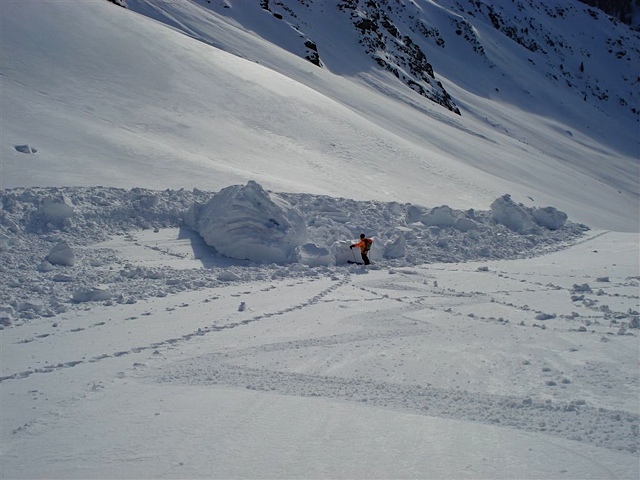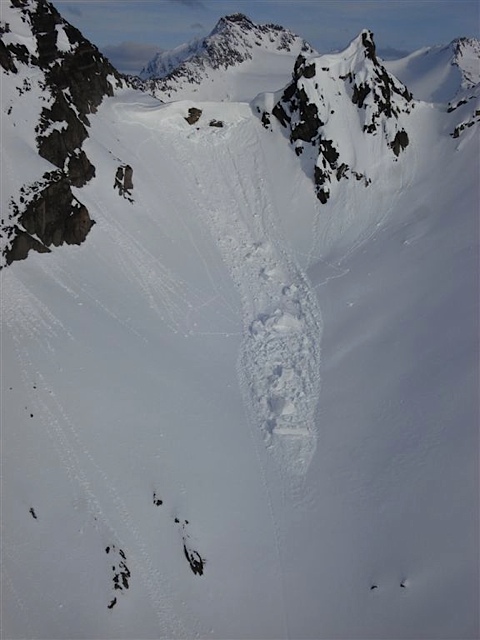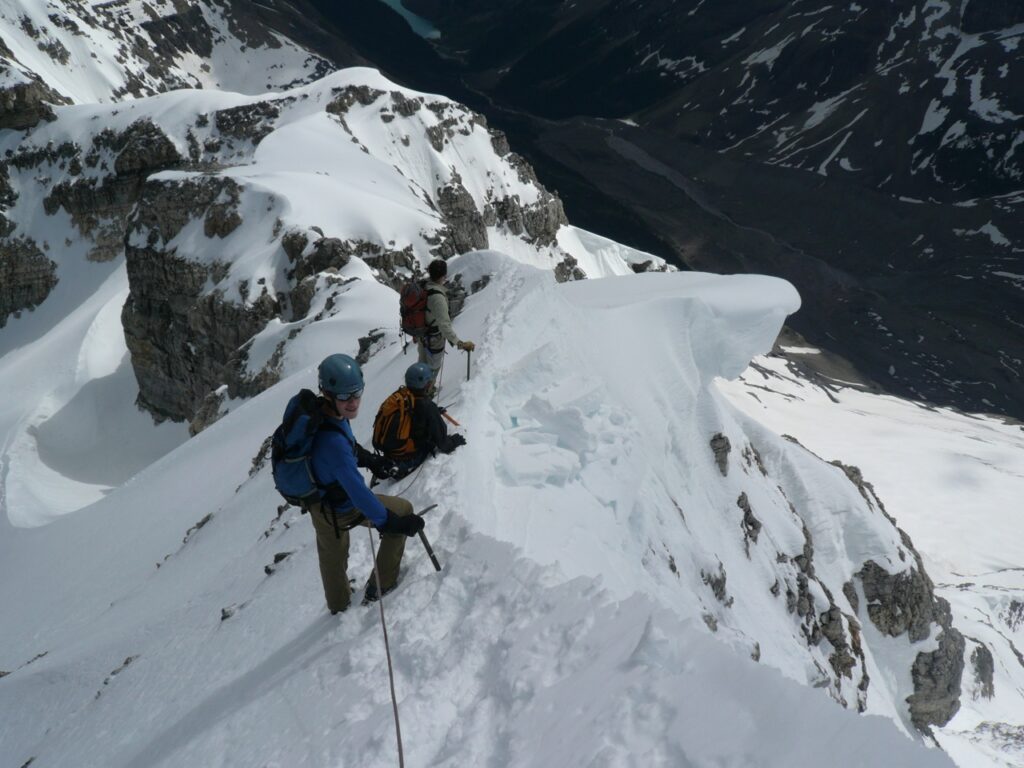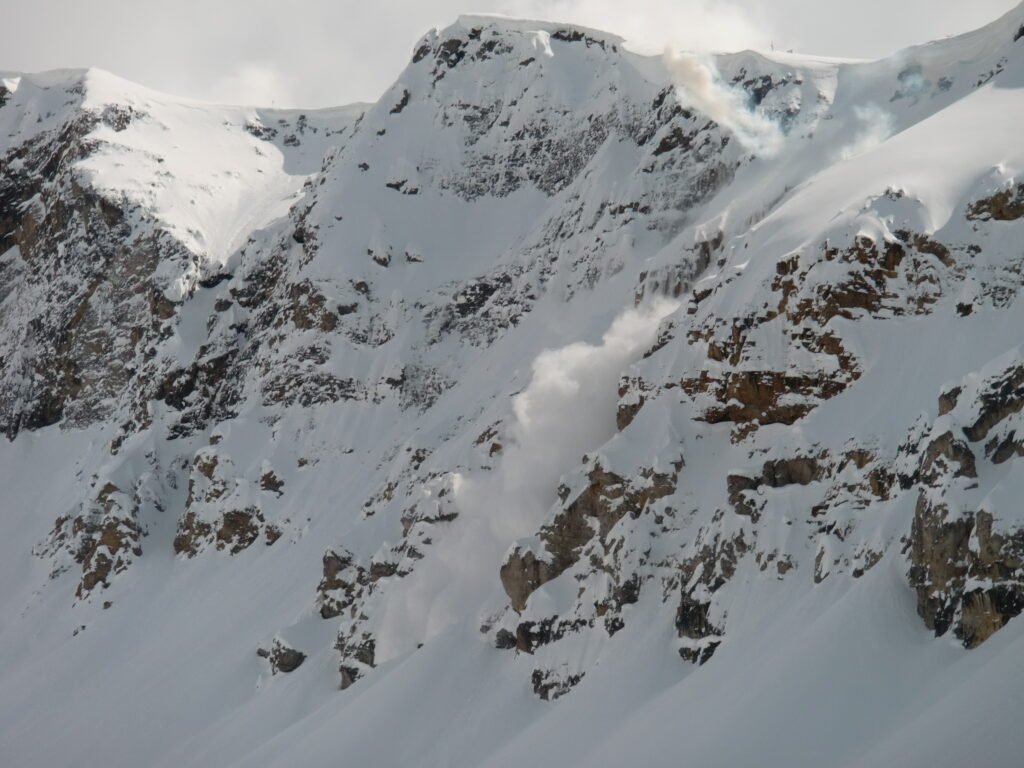These articles were originally published in The Avalanche Journal, Volume 107, fall 2014.
Introduction By Larry Stanier
Cornices are a simple fact of life in snowy mountains. As I write this in early August, I will still be dealing with them this coming week in the mountains. Talk to veteran big mountain ski patrollers and they will all have cornice control horror stories. Way too many professional and recreational skiers and climbers have fallen through cornices. Yet, since cameras first came into the mountains, we have seen photos of people standing cavalierly on cornices, skiing off them and climbing through them.
How do people get away with such behaviour when others die or come damn close every year? Though you won’t find the answers in these coming pages, we sure hope to stimulate some deep thought and careful consideration on the topic. Larger margins, better route finding, more probing, more belaying, bigger bombs and snow fencing would all help, but as usual our minds are probably the best tools if we know how to use them. I would sure like it if no one else I knew was injured or killed by a cornice fall.
Now You See Me, Now You Don’t
Story and photos by Bob Sawyer
In mid-April 2009, the snow stability and the character of the Cariboo mountains were at a season’s best, with a bluebird day to match. I took the reins of lead guide at CMH Cariboo Lodge that week—I was busy determining what to do and where to go, finally deciding to ski the north part of the tenure, which would result in north-facing glaciated terrain.
After four or five runs, we looked at a run called The Chute. We slowly did a dry run pass to check on landing and run features, as we only ski this line late in the season. Everything looked good. Once landed, I asked the pilot to move forward two meters or so and hold power while we exited the aircraft. I got out of the co-pilot seat and opened the sliding door, telling the door man to inform guests to move forward to the snow dirt line.
I moved around the front of the 212 towards the basket. As I grabbed the lower bar of the basket with both hands to open it, I heard a thunderbolt sound and found myself airborne. Stunned and holding on, I was flying and realized I had to make a decision quickly. Glancing downwards, it looked bad—as the milliseconds passed, I decided to cut loose, pushing back if possible. Upon landing (after a six to eight metre fall), I was barely able to get my radio out to call for help.
Once help had been established I tried to figure out my next move, as I could only see one other person. Running over to the broken edge, I saw three people—two standing and one on his back, non-responsive, three to four meters below. Running over to a safe entry to assist the three, I noticed a waving hand 40-50m below me in the lower cornice debris. After establishing an airway on the non-responsive guest, I moved down to the lower arm waver with transceiver on search.
Meanwhile, help started to arrive and I slowly accounted for all of my guests—not an easy task. All guests were taken to the local hospital and cleared of any trauma. After a late lunch back at the lodge, we resumed skiing and had a couple more runs. One could only imagine the outcome had luck not been with us. My thanks go out to super pilot Chris Norman and my very supportive guide group.





Mt. Collier Cornice Case Study
By Larry Stanier
Climbing conditions were good in the Rockies alpine in mid July 2010. Lots of summer snow was around, so rockfall and wet slides were probably the biggest hazards and were easily managed with a good freeze and fast, well-timed travel. Cornices were still a factor and avoidance was my main strategy.
The “Millar boys” from Lake O’Hara lodge are fit and good on their feet. I usually go as fast as I can with them, and they patiently try not to blow by me. We had been waiting for a fine day to climb the North Glacier on Mt. Collier from the O’Hara road, and now we had it. None of us had climbed it before.
Early morning had us up the glacier and onto the NE ridge, which was a little more complex and corniced than I had hoped. We passed the first few cornices easily, as we could scope them well in advance.
Then, we came to a bit of a mystery. It was obviously a huge cornice, with no simple way to scope it in advance. It was steep on the windward side (about 40 degrees), and there was a long, steep, rocky couloir below the lee side, but it looked like there should be a good anchor in solid rock on the far side.
I left the boys and went for a look. I really wanted to stay high, keep the flow going and avoid having the three of them do a steep descending traverse. But I was spooked and uncertain, so I went way down to where I felt I was just below the lowest possible fracture line, kicked in big steps, and was grateful to find an easy, solid anchor on the far side.
We were on to the summit from there and back to the mystery spot in about an hour. There were still no good views of the beast, so I rebuilt the anchor and belayed them down and across the steps. Kawhoosh! The big mofo broke right along the steps, slammed into the couloir, and, along with a big, wet, greasy avalanche, roars down onto the upper Victoria Glacier. The boys and I were impressed! The rope and anchor would have held the fall, but it would have been a fart knocker of a tumble before the rope stopped them.
Despite going much farther downhill than I would have liked, I still cut it too close. My imagination failed me, as I didn’t realize that the gap between the rocks was that deep and that the cornice was that big and poorly supported. Lesson learned (again): time and flow is important but wide margins are more important. It would have added maybe one minute to the day to go even a bit further downhill. That would have increased the risk and consequence of a fall while the boys were moving, but in hindsight I was sure I could get a good anchor, I had lots of faith in their movement skills, and little faith in my cornice size estimate. Probing may have helped but my 240cm summer probe may not have been long enough.
How do I apply those lessons? There are certainly no rules that should come out of an event like this, but my take home is realizing when I have a high degree of uncertainty around cornices I must leave an even bigger margin to account for that uncertainty. And the main thing is bringing everything (and everyone) home.

Cornice Theory at Sunshine Village
By Brendan Martland
Chaos theory: “a field of study in mathematics, with applications in several disciplines including meteorology and physics. Chaos theory studies the behaviour of dynamical systems that are highly sensitive to initial conditions—an effect which is popularly referred to as the butterfly effect. Small differences in initial conditions yield widely diverging outcomes for such dynamical systems, rendering long-term prediction impossible in general” (Wikipedia).
Cornice Theory: see above, and add increased uncertainty and a false sense of security due to the existence of a non-event feedback loop (B. Martland). Cornices are among the most challenging and unpredictable elements at play in avalanche forecasting. My experience with them, from both near and far, has been what might be described as an “unhealthy relationship.” Poor feedback, lots of mistrust, little understanding and the occasional spanking.

Basic cornice dynamics are well described and documented, but their failure is not extensively researched or well grasped by avalanche professionals. Several key heuristics (helpful decision-making “mental shortcuts”) have become commonly accepted within the industry. Some of these are very helpful:
- “Be cautious of any temperature spike, be it rapid warming or rapid cooling.”
- “Sudden or intense solar input is a common cornice trigger.”
- “Rapid windloading often causes a cornice release.”
- “Cornices can pull back all the way onto flat terrain well off a ridgeline.”
We can and do use these heuristics to help forecast and manage cornice failures, but what about all those times when nothing happens, or when you thought it would fail but did not? These often become a non-event feedback loop, where there is an ongoing lack of events (failures) that may lead to a false sense of confidence or security.
A cornice will often survive numerous dramatic sunrises, several cold spells after warm days, wind events of varying intensity and direction, even a cornice-cutting mission or a bomb sitting on top of it, and still hang in there somehow at the end of the day. In our world of confidence and uncertainty, cornices may well reign supreme.


My own perspective on cornices is mainly that of a ski resort avalanche technician and forecaster. As such, I have access to an arsenal of explosives, closure systems and human labour hours dedicated to decreasing or eliminating this particular hazard. My approach to the problem comes from a combination of all the hand-me-down heuristics that were mentored into me, and a key heuristic I developed on my
own. It is not a new or original concept, but one that so many of us had to learn the hard way before we really believed in it or followed it in practice.
Sunshine Village Ski and Snowboard Resort has a profound history of cornice-related near-misses, accidents and even a fatality. I will touch on a select few of these events in the interest of preventing similar accidents or close calls. I will then offer you my own solution and heuristic for cornice assessment and mitigation.
Fatality, beyond the South Side Chutes of Goat’s Eye Mountain
A 19-year-old male snowboarder left the ski area boundary for some fresh turns in the adjacent backcountry. At the top of the run, he stopped to take photos and have a look around. He decided to look at the view from the edge, with an acquaintance only a few feet away. As he took a step onto a cornice, he suddenly fell into space as it broke away from the ridgeline. The ensuing 445-metre fall proved to be unsurvivable.
In hindsight, this appears to be an obvious and avoidable accident. Unfortunately, cornices are not well understood or appreciated by the general public, and accidents like this continue to occur. As professionals, we have to try our best to educate the users we come into contact with of the dangers of cornices. We also have to set the example of complete avoidance whenever possible—there are times when one may be tempted to venture out onto a well-supported, mature cornice, but keep in mind that they have and will continue to fail with just a small amount of added stress or load. The weight of a person is sometimes all it takes to tip the scales, even with a dense, seemingly well-supported specimen.
Near Miss, Galaxy Ridge in Delerium Dive
At the far end of the ridge that defines the Delirium basin, there is a complicated ridgewalk that has occasionally been used to access the top of an outlying run named Milky Way, or more commonly to access the backcountry to the southeast. The leasehold is defined by the ridge itself, so technically speaking this feature is (just) outside of the ski hill boundary. There is an area on the ridge where a short, deep in-cut exists. By mid-winter, the feature is filled in and looks to be a part of the ongoing ridge, but, in fact, it is a short cornice bridge over a significant drop to a large, uncontrolled avalanche path.
In the last decade or so, there have been several separate parties with near-miss events on this same feature. There are likely more that the author is unaware of—the following all occurred to either avalanche professionals or professionals in training. In each instance, there was a group travelling across the terrain with someone out in the lead. All had close calls where a member of the party fell through the cornice and was then hanging by their arms, feet kicking in space. Fortunately these events did not end in injury or worse.

The solution we came up with is simple. Because the relatively small piece of cornice is difficult to access and quick to form, we now maintain a much lower traverse that avoids all exposure to the ridge. It may be a chore to take the more windward snow/scree option to make it to the col, but the extra effort is surely worth it. The hazard remains, but we do our best to alleviate any potential exposure. We also caution anyone who plans to travel on or near the ridge that the feature exists and has a history of surprising people.
As a take-away note for professionals, this should act as a reminder of the nuances of the mountain landscape. If you are not familiar with the terrain, stay well off the ridge whenever possible, even for micro-features that appear benign.
Near Miss, Member of the Public, Goat’s Eye Mountain
This event occurred on a late winter’s day in one of the southwest-facing chutes accessed from the Goat’s Eye chair. There were a number of fairly large chunks of cornice lingering along the cross-loaded ridges in this area, but efforts had been made to get rid of as many as possible. Early in the afternoon, the ski patrol received a call that there was a fresh pile of debris in one of the paths. They raced out to investigate and learned that a roughly 120-pound male had been standing on the very beginning of an overhanging portion of cornice in an easily accessed area when it failed in one go, with a 10m propagation. No slab was pulled on the slope below but the debris pile qualified as a size 2, piled up in a terrain trap gully feature to boot. Fortunately this was another near-miss event: no injuries, no lost gear. In the following days, we put a concerted effort into removing all the remaining pieces, with very mixed results: some failed quite easily, others were nearly impossible to dislodge.
The stable weather and non-event feedback leading up to this close call gave the staff no reason to suspect any of the cornices lingering in the area were touchy enough to be human-triggered. Evidently some were, while others were not. More information gathering combined with a more diligent approach to cornice control were seen as being the solution.

Near fatality, Staff Member, Lookout Mountain
On this day, a team of patrollers were conducting avalanche and cornice control in a steep piece of north-facing terrain. There was a large, mature cornice above much of the slope, which was being tested by throwing a series of hand-charges tied to ropes in order to get airblasts just below the cornice and above the start zones below. Fresh cornice growth was breaking off with the charges and mostly small, loose avalanches were failing on the slopes. After control was complete, a patroller entered the run by skiing off a section of cornice at a point where a ridge comes up from the run to split the feature somewhat. Two more people then approached the edge, when much of the entire 80m cornice-line failed catastrophically. This massive load then triggered a dormant deep persistent weak layer near the base of the snowpack, resulting in a size 3 avalanche.
Incredibly, only one person was carried right down to the runout zone several hundred metres below. There was a full burial and an extremely heroic, efficient rescue performed by another patroller who had chosen to spot the crew from the bottom. The injured patroller was flown away with life-threatening injuries. The two others that fell with the cornice managed to dig in and stay high in the start zone.
This event changed many people’s lives. A patroller nearly died, but thankfully a near-full recovery occurred after years of healing, both physically and mentally. Post-traumatic stress disorder was widespread among the staff, even among those who were absent on the day in question. Strategies and protocols were questioned, as well as revisiting the risk tolerance the program had been maintaining, and what it should strive to maintain. Was this a “low-probability, high-consequence” event that avalanche professionals literally lose sleep over? Perhaps it was closer to a “high-probability, high-consequence” event that was not recognized as such until after the fact.
Several key factors contributed to this accident: insufficient communication and a non-event feedback loop. The communication was not thorough enough for the team to opt to avoid this piece of terrain, which was the original plan. Assumptions were made and a hierarchy followed, and there may well have been too much weight placed on the stability of the slope itself and not enough on that of the cornice. The non-event feedback was the clincher: only small surface results, both on the slopes and the large cornice, led everyone involved to a false assumption. Had more shots been thrown, or the size of the charges increased, who knows what would have happened—possibly the same result, possibly not. Obviously, if the team had revisited the plan to travel through the terrain (which was still going to stay closed), then this accident could have been avoided. One of the most important aspects of the event’s aftermath is that it has and will continue to inform and remind others—professionals or not—about the danger and unpredictability of cornices.
Fortunately, we continue to evolve and work together as an industry to prevent such tragedies from occurring again. Listing cornices as an avalanche problem in the InfoEx or on a public avalanche bulletin helps to spur operational discussions on likelihood and sensitivity to triggers, as well as to track the problem closely and be mindful of trends and outliers. One thing is for certain: there will always be outliers, and there will always be non-event feedback loops.
Dealing with Cornices
Control work on cornices is something of a black art. I have spent hours digging in trunk-lines with sizeable charges only to crack the entire feature, making it even more suspect. On other occasions, trunk-lines have been dramatic and utterly productive, although I have personally never been a fan of all the exposure involved in setting up such a blast, and the time commitment associated with belaying, digging and stringing the shots in sequence. I have tried using shaped charges such as two-pound Rock Crushers sitting on top of the cornice—they do well on small pieces that are easy to place, but generally do not seem to be worth the extra expense. We have gotten only mediocre results after dropping bags of ANFO into large cracks or calving sections and then tamping them into place.

Det cord can be piled methodically into these as well—this strategy seems to be more effective on smaller, less mature pieces. I have cut all sorts of cornices off with knotted rope, which again has had very mixed results: sometimes the first attempt is successful, but often the rope gets stuck, the cornice is too dense to cut through, or sometimes—in fact, far too frequently for my fancy—the whole overhanging piece gets cut right through and somehow stays put. In more accessible terrain, a concerted effort to shave and shovel cornices as they form is perhaps the optimal mitigation technique; however, this is often not a feasible solution due to access issues and time constraints. Wind fences can certainly help reduce the speed of cornice growth, but they do not prevent their formation outright.
So what is the final answer? For us, it’s using everything in the arsenal. Our approach is to employ various techniques depending on the cornice in question: picking away as much as we can with shoveling and shaving new growth, building and maintaining wind fences on key ridgeline features, cutting small, touchy pieces with ropes, and hanging big charges off the lips of mature cornices seem to be the most effective in our terrain. We sometimes place a number of bags of ANFO with longer five-minute fuses on plastic saucer-style toboggans to deliver them off low-angled ridgelines—the toboggan can usually be brought back after the shot falls over the lip. This has produced the most consistent results for large mature cornices. If all of these approaches fail, then we are forced to play the final card for our operation: avoidance. Close the terrain, keep staff away and try another day.
As for the promised heuristic, I fear this one will be a tad on the disappointing side. I’m sure many readers have a similar one they bring out while teaching courses, training staff, guiding clients, or just ski touring with friends. Mine is short and to the point: “Cornices are always trying to fool you. Be afraid.”






